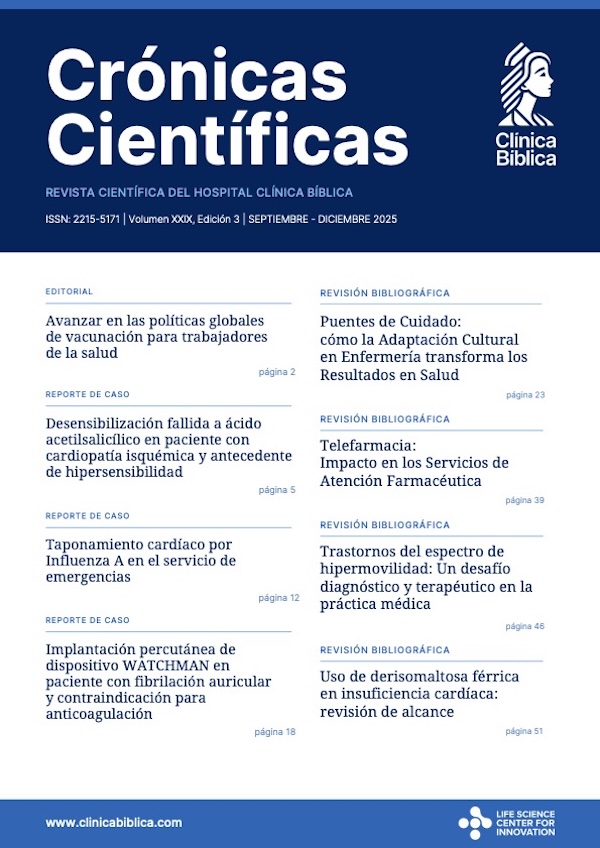- Visto: 1188
Revisión Bibliográfica
Revisión de trastornos pigmentarios cutáneos
Skin pigmentation disorders review
Edición XVI Setiembre - Diciembre 2020
DOI: https://doi.org/10.55139/CHJY5791
APA (7ª edición)
Arias Argüello, A. (2020). Revisión de trastornos pigmentarios cutáneos. Crónicas científicas, 16(16), 72-85. https://doi.org/10.55139/CHJY5791.
Vancouver
Arias Argüello A. Revisión de trastornos pigmentarios cutáneos. Cron cient. 11 de agosto de 2020; 16(16): 72-85.
Dra. Andrea Arias Argüello
Médico y cirujano general.
Universidad de Ciencias Médicas de Costa Rica.
Colegio de Médicos y Cirujanos de Costa Rica.
Trabajador independiente. Consulta privada. San José, Costa Rica.
Resumen
La variación en la piel y el color del cabello es el aspecto más notable de la variabilidad humana. La condición de la piel indudablemente atisbará la existencia de salud y belleza, por lo cual el conocimiento de su homeostasis así como de su ausencia permite desarrollar un enfoque apto no solo para el tratamiento de enfermedades cutáneas sino también para cuidar adecuadamente de esta. Este artículo inicia con la descripción de la melanogénesis así como de la influencia de los factores genéticos y ambientales que permitirá al lector comprender mejor el origen de los trastornos de la pigmentación cutánea más frecuentes, tanto por exceso (hiperpigmentación) como por defecto (hipopigmentación). Aunque en su mayoría, son trastornos benignos, algunos resultan en preocupaciones cosméticas o psicológicas para el paciente, que requieren evaluación y tratamiento. El diagnóstico adecuado le permite al médico facilitar el tratamiento apropiado, brindarle tranquilidad o iniciar una derivación oportuna.
Palabras claves
Color de piel, pigmentación, piel, melanocitos, , hiperpigmentación, hipopigmentación.
Abstract
Variation in skin and hair color is the most notable aspect of human variability. The condition of the skin will undoubtedly glimpse the existence of health and beauty, for which the knowledge of its homeostasis as well as its absence allows to develop a suitable approach not only for the treatment of cutaneous diseases but also to treat the disease of the same. This article begins with the description of the melanogenesis as well as the influence of the genetic and environmental factors that can be selected for the reader to better understand the origin of the most frequent skin pigmentation disorders, both due to excess, hyperpigmentation, and defect, hypopigmentation. Although mostly, they are benign disorders, some affected in cosmetic or psychological concerns for the patient, that require evaluation and treatment. Proper diagnosis allows the physician to facilitate appropriate treatment, provide reassurance, or initiate a timely referral.
Keywords
Skin color, pigmentation, skin, melanocytes, hyperpigmentation, hypopigmentation.
Bibliografía
Bastonini, E., Kovacs, D. y Picardo, M. (2016). Skin Pigmentation and Pigmentary Disorders: Focus of Epidermal/Dermal Cross-Talk. Annals of Dermatology, 28(3), 279-289.
Boukar, F., Jourdan, E., Fontas, E., Montaudié, H., Castela, E., Lacour, J.P. y Passeron, T. (2015). Prevention of melasma relapses with sunscreen combining protection against UV and short wavelengths of visible light: a prospective randomized comparative trial. Journal of American Academy of Dermatology, 72(1), 189-190.
Dabas, G., Vinay, K., Parsad, D., Kumar, A. y Kumaran, M.S. (2020). Psychological disturbances in patients with pigmentary disorders: a cross-sectional study. Journal of the European Academy Dermatology and Venereology, 34(2), 392-399.
Dayal, S., Sahu, P. y Dua, R. (2016). Combination of glycolic acid peel and topical 20% azelaic acid cream in melasma patients: efficacy and improvement in quality of life. Journal of Cosmetic Dermatology, 16(1), 35-42.
Del Bino, S., Duval, C. y Bernerd, F. (2018). Clinical and Biological Characterization of Skin Pigmentation Diversity and Its Consequences on UV Impact. International Journal of Molecular Sciences, 19(9), 2668.
Grimes, P.E. y Miller, M.M. (2018). Vitiligo: Patient stories, self-esteem, and the psychological burden of disease. International Journal of Women's Dermatology, 4, 32-37.
Grimes, P.E. y Nashawati, R. (2017). Depigmentation therapies for vitiligo. Dermatologic Clinics, 35(2), 219-227.
Gopichandani, K., Arora, P., Garga, U., Bhardwaj, M., Sharma, N. y Gautam, R.K. (2015). Hormone profile of melasma in Indian females. Pigment International, 2, 85-90.
Lim, H.W., Grimes, P. E., Agbai, O. Hamzavi, I., Henderson, M., Haddican M., Linkner, R., Lebwohl, M. (2015). Afamelanotide and narrowband UV-B phototherapy for the treatment of vitiligo: a randomized multicenter trial. Journal of the American Medical Association Dermatology, 151(1), 42-50.
Mazurek, K. y Pierzchala, E. (2016). Comparison of efficacy of products containing azelaic acid in melasma treatment. Journal of Cosmetic Dermatology, 15(3), 269-282. doi: 10.1111/jocd.12217.
Ogbechie-Godec, O.A. y Elbuluk, N. (2017). Melasma: an Up-to-Date Comprehensive Review Dermatology and Therapy, 7(3), 305-318.
Plensdorf, S., Livieratos, M. y Dada, N. (2017). Pigmentation Disorders: Diagnosis and Management. American Family Physician, 96(12), 797-804.
Rahrovan, S., Fanian, F., Mehryan, P., Humbert, P. y Firooz, A. (2018). Male versus female skin: What dermatologists and cosmeticians should know. International Journal of Women's Dermatology, 4, 122-130.
Rendon, M.I. (2019). Hyperpigmentation Disorders in Hispanic Population in the United States. Journal of Drugs in Dermatology, 18(3), s112-114.
Torres, V., Herane, M.I., Costa, A., Piquero, J. y Troielli, P. (2017). Refining the ideas of “ethnic” skin*. Anais Brasileiros de Dermatologia, 92(2), 221-225.
Whitton, M.E., Pinart, M., Batchelor, J. Leonardi-Bee, J., González U., Jiyab Z., Eleftheriadou V., Ezzedine K. (2015). Interventions for vitiligo. Cochrane Database Systematic Review, (2), CD003263SKI.
Zubair, R., Lyons, A.B., Vellaichamy, G., Peacock y A., Hamzavi, I. (2019). What's New in Pigmentary Disorders. Dermatologic Clinics, 37(2), 175-181.
APA (7ª edición)
Arias Argüello, A. (2020). Revisión de trastornos pigmentarios cutáneos. Crónicas científicas, 16(16), 72-85. https://doi.org/10.55139/CHJY5791.
Vancouver
Arias Argüello A. Revisión de trastornos pigmentarios cutáneos. Cron cient. 11 de agosto de 2020; 16(16): 72-85.
Esta obra está bajo una licencia internacional Creative Commons: Atribución-NoComercial-CompartirIgual 4.0 Internacional (CC BY-NC-SA 4.0)

Realizar búsqueda
Última Edición
Ediciones Anteriores






